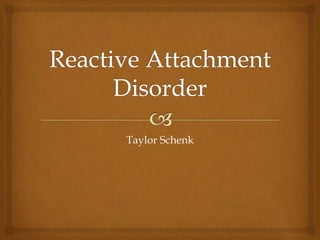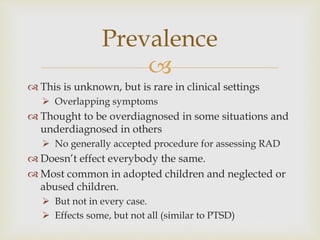Reactive attachment disorder
- 2. The theory that when humans are born they are born extremely immature and are not able to survive without protection. So at birth they are prepared to attach themselves to a caregiver for protection and safety. Attachment Theory
- 3. During this critical time when the child attaches to the caregiver something disrupted it such as: Death of primary caregiver Switching of caregivers Abuse or neglect of the child This leaves the child feeling vulnerable and uncomfortable. doesn’t learn how to form meaningful relationship Lack of that secure base for them to explore the world. Applied to RAD
- 4. Lack of affection Resists social interactions Would rather be alone Delays in cognitive, language, and motor skills Behavioral problems Aggression and violent Inappropriate attaching Receive comfort from any available adult, even strangers Anger and irritability Characteristics of RAD
- 5. Criteria A Consistent Pattern of inhibited, emotionally withdrawn behavior towards a caregiver, manifested by both of the following: 1. Child rarely or minimally seeks comfort when distressed 2. Child rarely or minimally responds to comfort when distressed DSM-V Criteria
- 6. Criteria B: A persistent social and emotional disturbance characterized by at least two of the following: 1. Minimal social and emotional responsiveness to others 2. Limited positive affect 3. Episodes of unexplained irritability, sadness, or fearfulness that are evident even during nonthreatening interactions with caregiver DSM-V Criteria
- 7. Criteria C: Child has experienced a pattern of extremes of insufficient care as evidenced by at least one of the following: 1. Social neglect or deprivation in the form of persistent lack of having basic emotional needs of comfort, stimulation, and affection met by the caregiving adults 2. Repeated changes of primary caregiver that limits opportunities to form stable attachment 3. Rearing in unusual setting that severely limit opportunities to form selective attachment. DSM-V Criteria
- 8. Criteria D: Care in criterion C is presumed to be responsible for the disturbed behavior in criterion A Criteria E: Criteria not met for Autism Spectrum Disorder Criteria F: Disturbance is evident before age 5 Criteria G: Child has developmental age of at least 9 months DSM-V Criteria
- 9. Effects neglected or abused children Onset before age 5 Often effects adopted children If removed from parent within weeks of birth Doesn’t effect every child the same. Can have 20 in same situation and only 2 have RAD argued there may be a genetic factor Etiology
- 10. This is unknown, but is rare in clinical settings Overlapping symptoms Thought to be overdiagnosed in some situations and underdiagnosed in others No generally accepted procedure for assessing RAD Doesn’t effect everybody the same. Most common in adopted children and neglected or abused children. But not in every case. Effects some, but not all (similar to PTSD) Prevalence
- 11. PTSD Anxiety Depression Conduct disorder Personality disorders Comorbidity
- 12. There is no agreed upon treatment for RAD Treatments usually patient specific. Holding Therapy (rage reduction, “rebirthing”) Very controversial and unethical Has resulted in death But has a higher success rate than past treatments Creates more problems than it solves Treatment
- 13. Psychotherapy Dyadic Developmental Psychotherapy Maintain an affectively attuned relationship Attachment Therapy Play therapy, paint therapy, child-parent intervention Behavioral Management Therapy Treats the behavioral symptoms Acts more as a band aid Treatments
- 14. One of the most under researched and least understood disorder Don’t know where it comes from Don’t know to effectively treat it Can’t agreeably diagnose RAD Critisms













